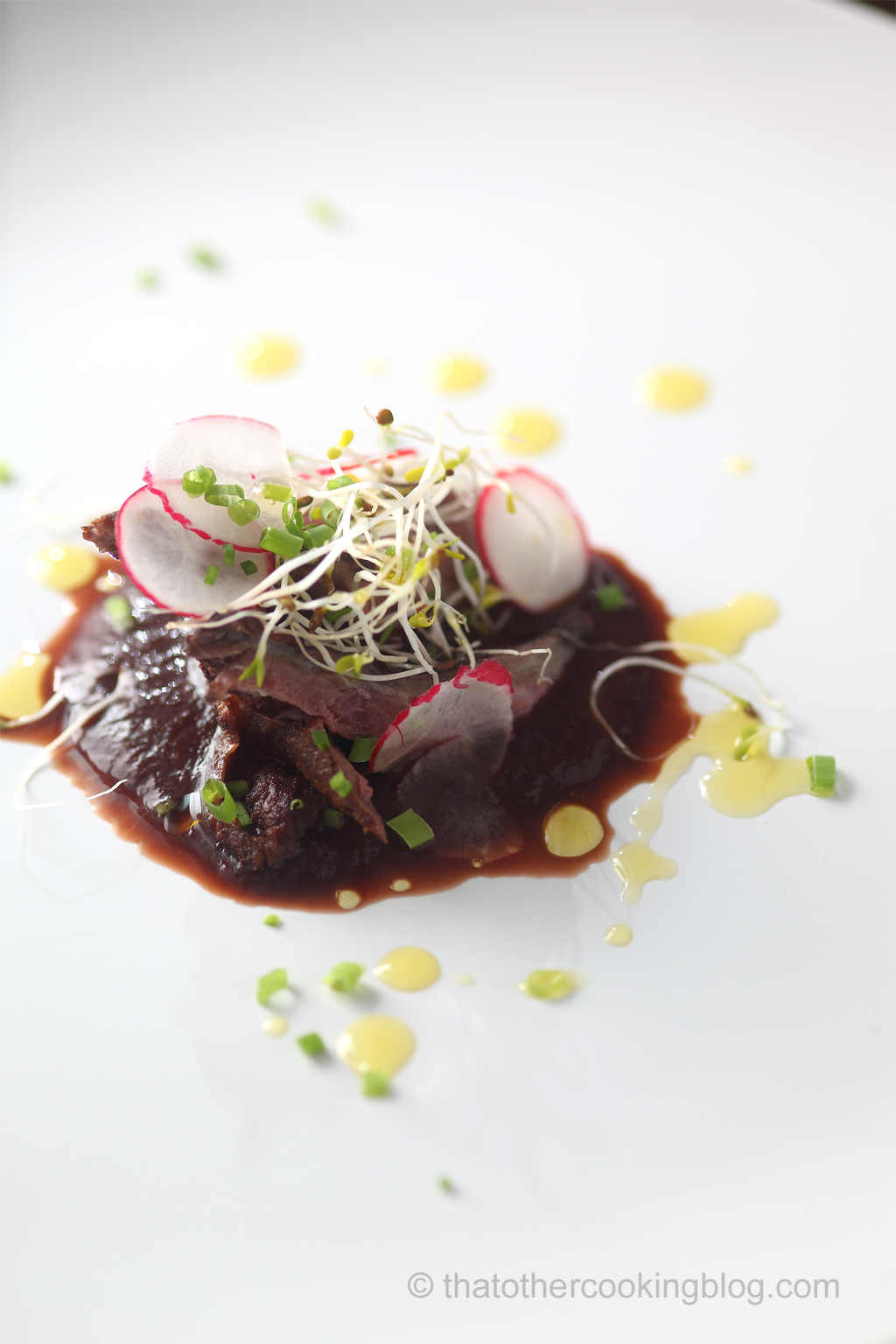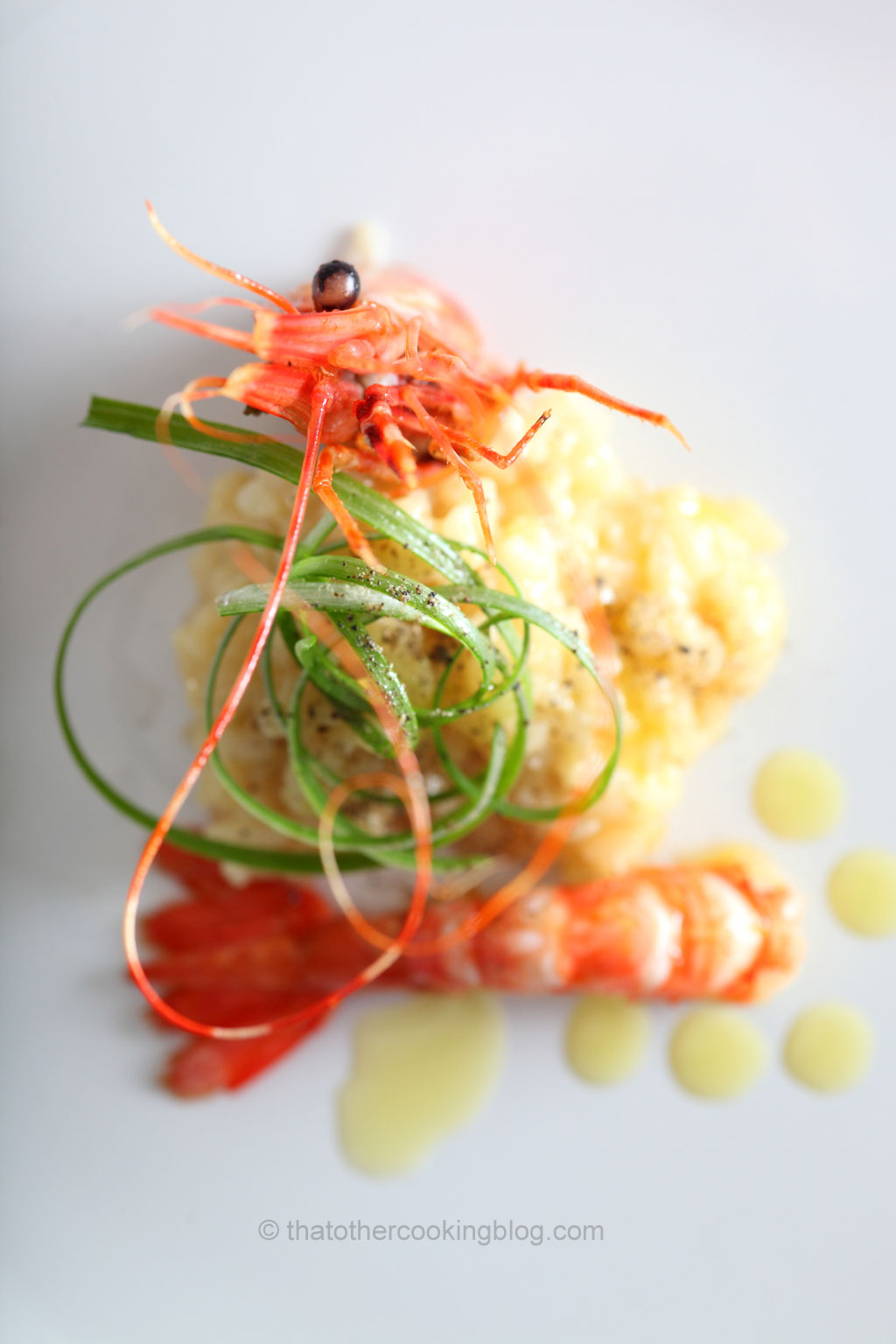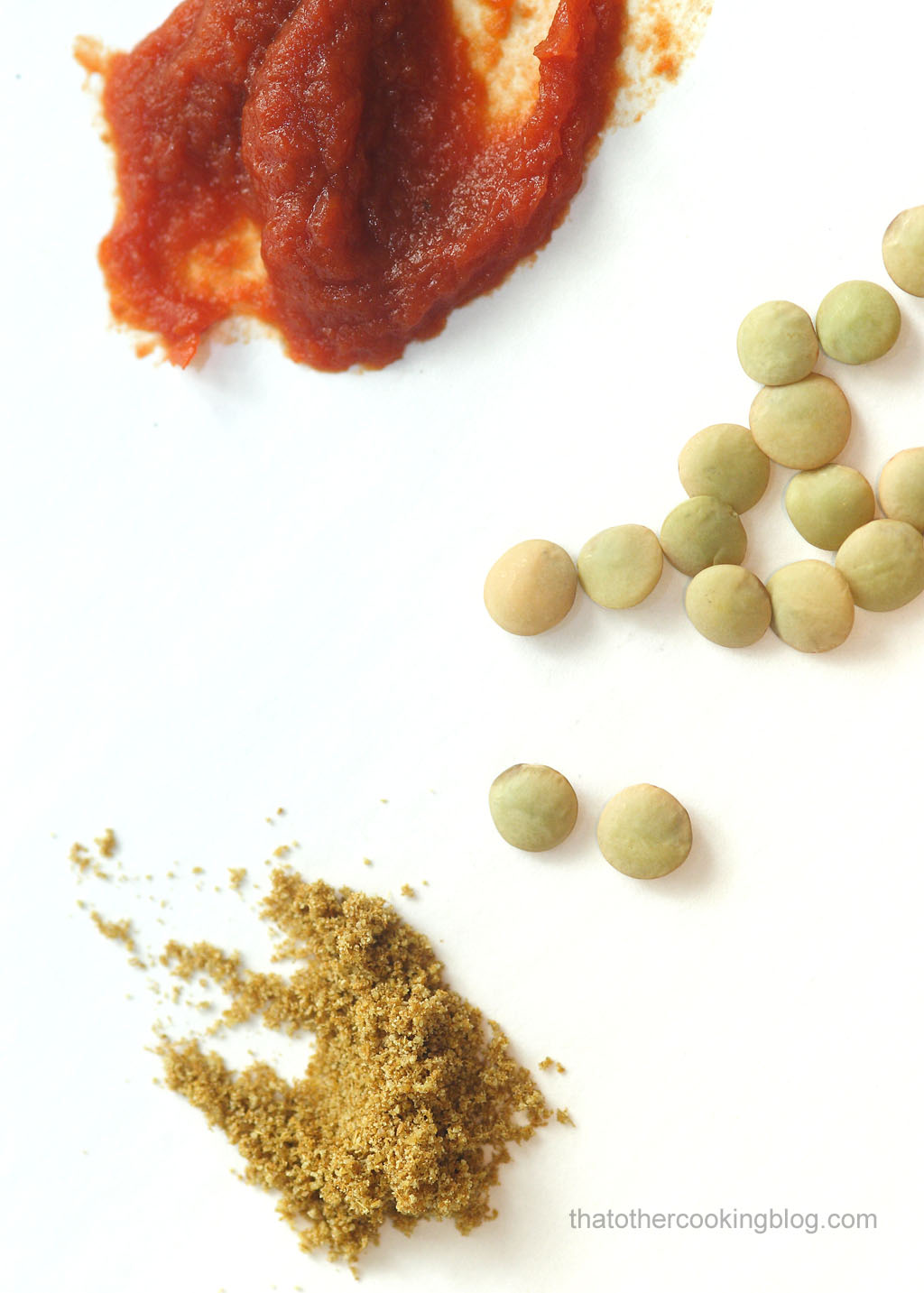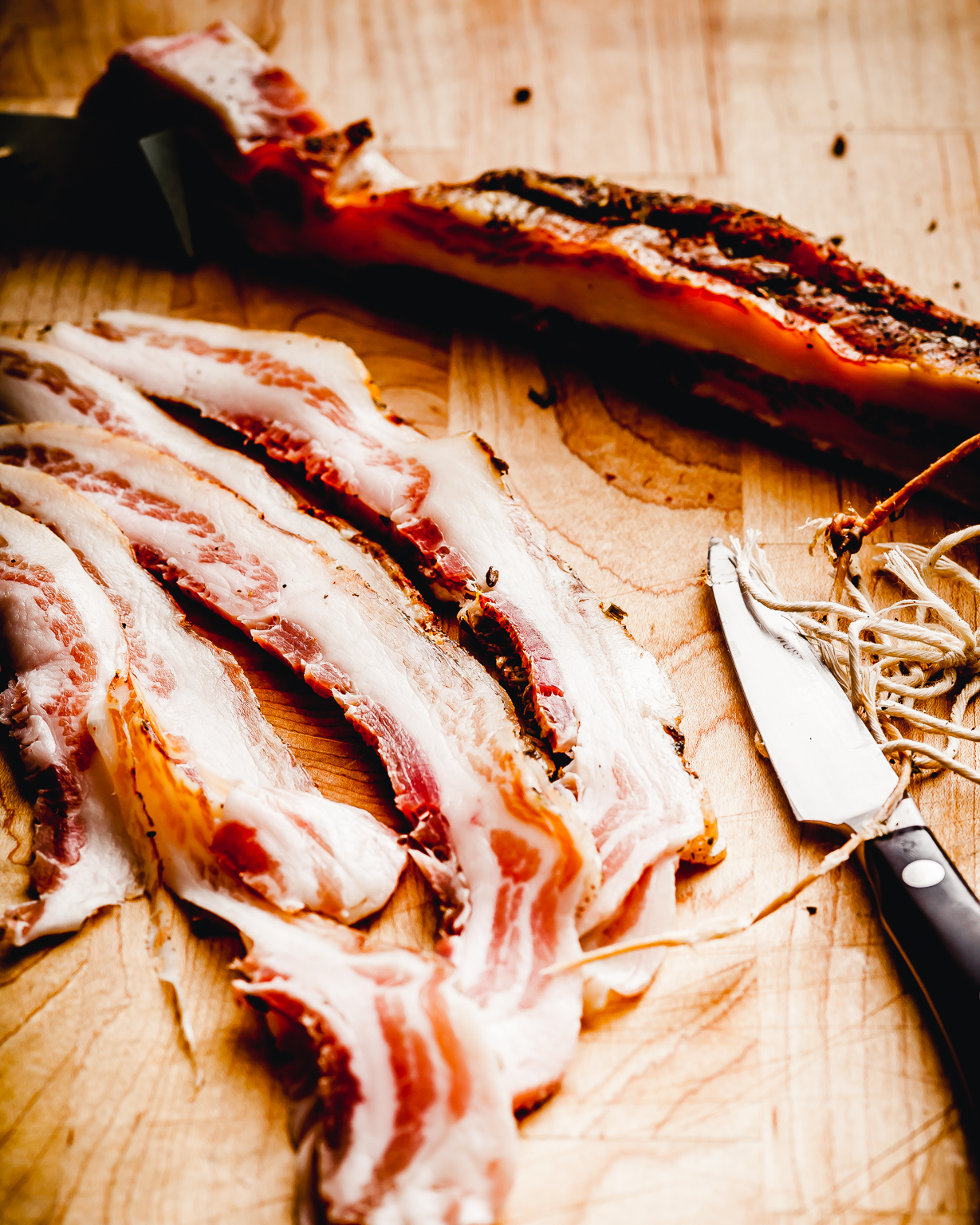I like it when the ingredients drive the recipe. I found these beautiful short ribs at the store and immediately dropped whatever cooking plans I had previously. I picked a few more things for the wine reduction as well. 72 hours later, I picked the rest of the ingredients, like the garnishes and such. After such a long cooking time at low temperature, short ribs are literally transformed into something that’s hard to describe here. They more closely resembled rib eye with an intense meaty flavor. Tender and juicy, with an amazing texture. My previous experiences cooking short ribs had been by braising them in wine, vegetables and stock in the oven for a few hours. This approach yields fall of the bone, delicious results. The meat though, is overcooked in order to break down the connective tissue within a reasonable time. At 54 degrees celsius, the time required to achieve the same is about 3 days. Cooking the meat sous vide, allows for something otherwise impossible to achieve traditionally. The meat will be medium rare. You can also adjust the temperature and cooking time to achieve a number of different doneness levels and textures to suit your preference.

I finally work a bit on the lighting setup in my kitchen and went back to using my speedlite flash which I really really like. Back to handheld photography (yay) which is super fast and flexible (getting on a tripod is a good option when shooting with natural light, the only option if you want sharp pictures really). I had to use a little remote trigger for the speedlite so it wouldn’t have to be mounted on the camera which can be very restrictive and how I usually have taken the photos for most of my previous posts. I also chose my 105mm sigma macro lens for this post, mainly because I love close up photography and macrophotography, but I also wanted to plate a smaller portion for the final dish. Appetizer style.

Ingredients:
2 lb short ribs (rack or individually cut)
Wine reduction:
1 can san marzano pureed tomatoes
1000ml beef stock
5 garlic cloves, crushed
750ml of a good red wine. I used a merlot.
1 celery stalk, small dice
1 large carrot, small dice
1 medium onion, small dice
1 bouquet garni
1 crushed bay leaf
white wine vinegar
Extra virgin olive oil
sugar, salt and black pepper to taste

Chimichurri dressing:
1 parsley bunch
1 cilantro bunch
1/3 C Olive oil
1/4 C White wine vinegar
Salt and pepper to taste

Garnishes:
Radishes thinly sliced
Chives finely chopped
Arugula leaves
Garlic sprouts

Searing the ribs. Before searing the ribs, salt them generously and allow them to rest for an hour or two. In a really hot cast iron or stainless steel pan. Brown evenly. Work in batches and avoid overcrowding the pan. Reserve the ribs and allow them to cool off before going in the sous vide bag. Discard half of the cooking oil. Use this same pan for the second step of the wine reduction.

Wine reduction. Step 1. In this recipe, I decided to reduce the wine on its own. Flambee when simmering, make sure all the alcohol has burned off. Reduce to about 150ml. Reserve.
Wine reduction. Step 2. In a wide saucepan over medium heat (same pan used to sear the ribs). Add some vegetable oil. Or use olive oil if you prefer. Add the onion, carrot, celery and some salt and cook until slightly browned, about 10-15mins. Add the pureed tomatoes and garlic, and cook until tomato puree is deep brown. Add the stock, the reduced wine. Add the bouquet garni, the bay lead and simmer for about 35 mins uncovered. Adjusting the flavoring of this reduction is hard to describe in a recipe. Taste every few minutes, adjust salt, acidity, add vinegar and or sugar. Some pepper. Basically, adjust to your liking. Before achieving sauce consistency, strain the sauce and discard the liquids. Return strained sauce to the pan and reduce until syrupy. Allow to cool. This sauce doesn’t need any thickeners. Tomatoes to most of the thickening (pectin) and the collagen in the ribs (that will be released during the sous vide step). There should be about a cup of sauce at this point.



Sous vide step. Add the sauce and the short ribs into the sous vide bag and seal. Vacuum seal. I used the water displacement method. Should work totally fine. One thing to note. I’m using ziplock bags. They are reliable for up to 24 hours.. after that, I’ve noticed the water in the immersion circulator get a bit cloudy from some of the cooking liquid escaping the ziplock bag. I’m gonna need to find a better bag. Anyways… cook at 54C for 72 hours more or less. Remove the ribs form the bag and reserve. Strain the liquid and place in clean saucepan.
Wine reduction. Step 3. Reduce the liquid until really syrupy. Final seasoning adjustments might be needed. Reserve.

Chimichurri dressing. You can remove the parsley and cilantro stems. I only cut off a portion of them and discarded the ends. Chop the rest coarsely. Add to a blender. Add some of the oil and vinegar. Run the engine. Stop the engine, push down on the leaves with a spatula or wooden spoon. Run the engine again. It’s a bit of a balancing act. Add more liquid. Stop the blender. Push down on the leaves. Run the engine. Eventually the chimichurri will liquify and blend nicely on its own. Remember this sauce has to be pretty thick and be runny at all. Run the blender for a good 5 minutes. Adjust salt and pepper. Add some oregano if you like. This is a great sauce to keep in the fridge and it stays for a few weeks and develops better flavor overtime as well.

Plating. Spoon sauce over the plate. Dress some rocket leaves with chimichurri. Place over the sauce. Slice the meat off the ribs. Add a few slices and top with the sliced radishes. Sprinkle the chives and some olive oil. Serve.


Wanna get more sous-vide cooking guides and cool cooking how-to’s in your mailbox? You know what needs to be done!
We never spam. You should only be getting updates when new content is posted on the site. We also respect your privacy. We don’t share your email address with anyone and you can unsubscribe anytime!





16 comments
Incredible! Looks amazing!!!
thank you Lotis!
Amazing photos – especially the wine reduction ones!
The food also looks great… 😀
Thank you Ronit! so glad you liked it 🙂
Wow this is stunning. Such a great recipe. I love your photos. I also like that you use wine in this dish. What a beautiful documentary of the reduction! Yum. I am definitely going to have to do this soon.
thanks Amanda!!! Really glad you like the recipe 🙂 You definitely have to try this thing, it was amazing! the ribs alone were worth it. Hope you have a great weekend!
Ahh, I cannot express how much I love this post, Paul! Your photos are phenomenal!! You’ve definitely figured out your lighting predicament, that’s for sure!! 😀
:)!!! Thank you so much Patty! Coming from you, this is awesome! Yeah, having a little area with the lighting conditions under control helped tremendously. Hope you’re having a wonderful father’s day weekend!
Thanks and same to you, Paul! 😀
reconnecting thoughts
Can I cook it for less time? And if yes what’s the difference in temperature?
Absolutely. The less time the higher the temperature. At 100C you’re looking at 3 hours. If you want to go for something like medium so it’s still a bit pink, you can try 65 for maybe 24 hours. I haven’t tried it but it’s a good guess.
Paul, just reading the Momofuku cookbook, and he has his short ribs at 60 degrees for 48 hours. Opinion?
hi Mimi! Tough cuts can be cooked to a wide range of temperatures and times and be awesome. Chef Chang obviously knows what he’s doing and tough cuts cooked at 60C tend to have a texture similar to BBQ. Closer to fall-off-the-bone tender but still with good structure and nice rosy doneness (pork ribs or brisket are popular at 60C). My recipe above is more aimed to give you that rare prime rib/ fillet mignon texture and virbant color. I’d love to go to his restaruant one day 🙂